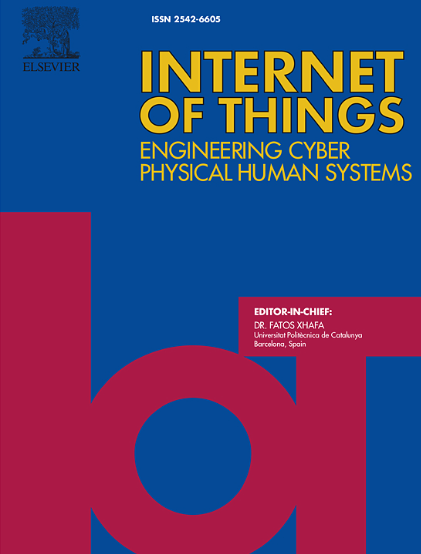一种有效的基于遗传算法的防御方法,以减轻rpl支持的物联网网络中的多重攻击
IF 6
3区 计算机科学
Q1 COMPUTER SCIENCE, INFORMATION SYSTEMS
引用次数: 0
摘要
物联网(IoT)是数十亿设备在互联网上的互联。它是各种概念、协议和技术的保护伞,用于在生产力和自动化方面创造许多好处。尽管它提供了好处,但也存在挑战,例如物联网设备的高成本,时间限制以及攻击者经常利用的互联网协议和技术的过度使用。为了解决这个问题,物联网网络必须具有安全的路由协议,可以为网络提供安全性,并利用现有技术的优势。然而,缺乏基础设施、动态拓扑变化、资源约束和不可靠的链路使得即使是现有最好的协议“低功耗和有损网络路由协议(RPL)”也容易受到各种攻击。除了信任管理之外,确保只有可靠和合法的节点参与路由决策,这是许多现有解决方案未能考虑的另一个关键方面。因此,在本研究中,我们提出了一种新的安全路由技术“基于遗传算法的RPL可信框架(GATE-RPL)”,该技术支持多拓扑路由,并为物联网网络中的各种设备提供安全性。为了克服安全问题,提出的工作:(i)提供了一种“动态信任管理技术”,该技术使用K-means聚类和扩展遗传算法的组合来最大化节点,链路和路由性能的信任;然后(ii)找到网络中每个节点之间的可信路由路径。实验结果表明,平均丢包率为0.012%,吞吐量为10.5 Mbps,识别可信路由路径的准确率为99%。本文章由计算机程序翻译,如有差异,请以英文原文为准。
An efficient Genetic algorithm-based defensive method to mitigate multiple attacks in RPL-enabled IoT network
Internet of Things (IoT) is the interconnection of billions of devices over the Internet. It is an umbrella of various concepts, protocols, and technologies that are used to create numerous benefits in productivity and automation. Despite the benefits it provides, there are challenges such as high cost of IoT devices, time-constraints, and overuse of Internet protocols and technologies which attackers often take advantage. To address this, IoT networks must have secure routing protocols that can provide security to the network and also utilize the benefits of existing technologies. However the lack of infrastructure, dynamic topology changes, resource constraints, and unreliable links make even the best existing protocol “Routing Protocol for Low Power and Lossy Network (RPL)” to be vulnerable for various attacks. Besides the trust management, that ensures only the reliable and legitimate nodes to participate in routing decisions, is another critical aspect that many existing solutions fail to consider. Hence, in this research, we propose a novel secure routing technique “Genetic Algorithm-based Trusted framEwork for RPL (GATE-RPL)” that supports multi-topology routing and provides security to various devices in the IoT network. To overcome the security issues, the proposed work:(i) provides a “dynamic trust management technique” that maximizes the trust of nodes, links, and routing performance using a combination of K-means clustering and extended Genetic algorithm; and subsequently (ii) finds a trusted routing path between every node in the network. The experimental results indicate an average of 0.012% packet loss, 10.5 Mbps throughput, and 99% accuracy in identifying trustworthy routing paths.
求助全文
通过发布文献求助,成功后即可免费获取论文全文。
去求助
来源期刊

Internet of Things
Multiple-
CiteScore
3.60
自引率
5.10%
发文量
115
审稿时长
37 days
期刊介绍:
Internet of Things; Engineering Cyber Physical Human Systems is a comprehensive journal encouraging cross collaboration between researchers, engineers and practitioners in the field of IoT & Cyber Physical Human Systems. The journal offers a unique platform to exchange scientific information on the entire breadth of technology, science, and societal applications of the IoT.
The journal will place a high priority on timely publication, and provide a home for high quality.
Furthermore, IOT is interested in publishing topical Special Issues on any aspect of IOT.
 求助内容:
求助内容: 应助结果提醒方式:
应助结果提醒方式:


